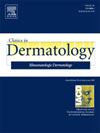Melanoma in older adolescents and young adult patients: A population-based analysis of the Surveillance, Epidemiology, and End Results Program database from 2000 to 2019
IF 2.3
4区 医学
Q2 DERMATOLOGY
引用次数: 0
Abstract
Epidemiologic characteristics of melanoma in older adolescents and young adult (AYA) patients aged 15 to 39 years are unknown. We examined the epidemiologic characteristics of melanoma in AYA patients and then extracted demographic and pathologic data for this retrospective cohort study from the Surveillance, Epidemiology, and End Results database (2000-2019). Cox regression analyses were used to assess the risk of all-cause death, cancer-specific death, and second primary malignancy. A total of 2,835 AYA patients with melanoma were included, of whom 926 (32.66%) had a second primary malignancy. The incidence of melanoma in AYA patients decreased from 0.9 per 1,000,000 person-year in 2000 to 0.2 per 1,000,000 person-year in 2019, with an average annual percentage change of −6.3% (95% CI, −7.2% to −5.3%). Melanoma patients who were darker skinned (Black) (hazard ratio, 3.794; 95% CI, 1.382-10.412) were associated with an increased risk of second primary malignancies, whereas patients with a Breslow depth of >4 mm (hazard ratio, 0.517; 95% CI, 0.379-0.706), melanoma site on the trunk (hazard ratio, 0.700; 95% CI, 0.536-0.915), and extremities (hazard ratio, 0.760; 95% CI, 0.585-0.988) were associated with a decreased risk of second primary malignancies. This study may provide statistical data on the epidemiologic characteristics of melanoma in AYA patients.
求助全文
约1分钟内获得全文
求助全文
来源期刊

Clinics in dermatology
医学-皮肤病学
CiteScore
4.60
自引率
7.40%
发文量
106
审稿时长
3 days
期刊介绍:
Clinics in Dermatology brings you the most practical and comprehensive information on the treatment and care of skin disorders. Each issue features a Guest Editor and is devoted to a single timely topic relating to clinical dermatology.
Clinics in Dermatology provides information that is...
• Clinically oriented -- from evaluation to treatment, Clinics in Dermatology covers what is most relevant to you in your practice.
• Authoritative -- world-renowned experts in the field assure the high-quality and currency of each issue by reporting on their areas of expertise.
• Well-illustrated -- each issue is complete with photos, drawings and diagrams to illustrate points and demonstrate techniques.
 求助内容:
求助内容: 应助结果提醒方式:
应助结果提醒方式:


